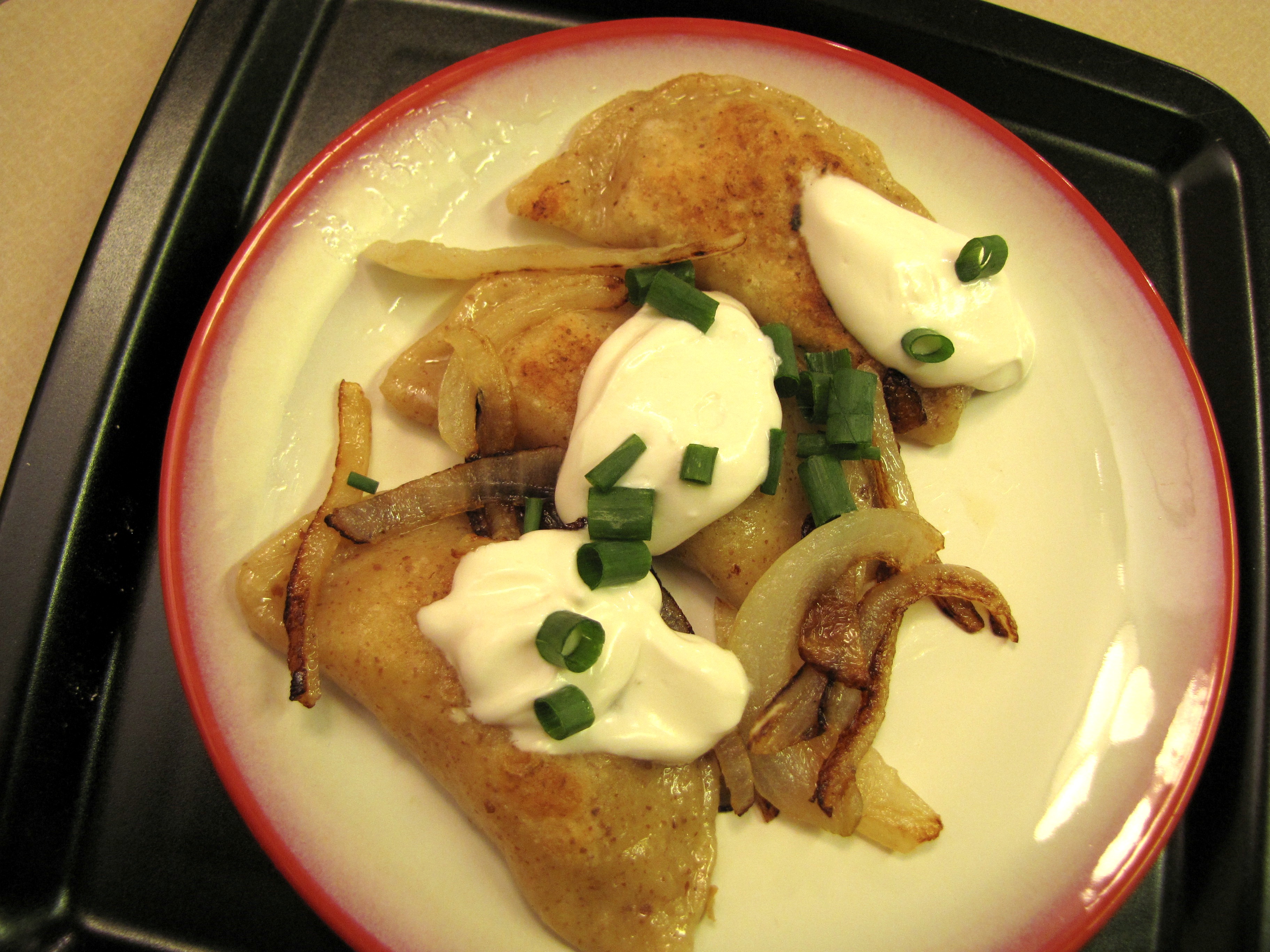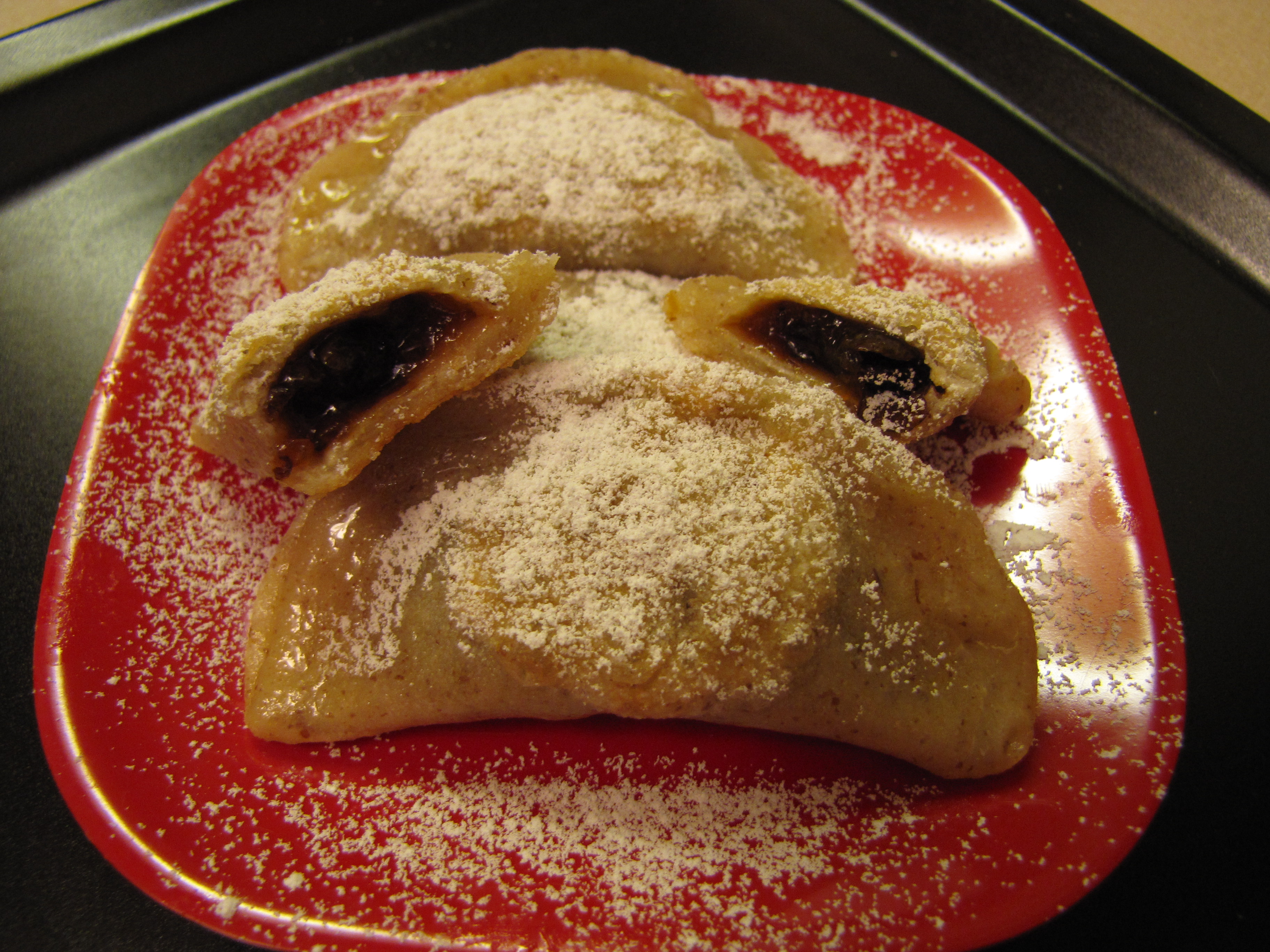episode 2: pierogi!
Welcome to Episode 2 of the nom! nom! nom! blog cooking show! In this episode Jim and I pay homage to our homelands and make our favorite starch-filled treat- pierogi! Here’s a little grammatical side note: the word pierogi is the plural, the singular is actually pierog.
[viddler id-f355483d h-370 w-437]

Potato-filled pierogi is about as classic as it gets.

Dried plum-filled pierogi may sound strange, but they are tangy, sweet and complex, a family favorite.
For this recipe, one of the fillings fills the whole batch of dough, so if you want to make both you will need to double the dough recipe. If you make both, also be sure to keep tabs on which one is which, you don’t want to sautee your sweet pierogi with onions!
Pierogi
Yields: 30 pierogi
Dough:
1 tbsp. ground flaxseed
2 tbsp. water
2 cups flour
1/2 teas. salt
2 tbsp. oil
1 cup water
In a small bowl, combine flax with 2 tbsp of water. Whisk and let sit to thicken. In a large bowl, combine flour and salt. Make a well in the flour and add the oil, water and flax mixture. Mix until well combined, kneading on a clean surface until a nice dough comes together.
Roll out dough to 1/16 inch thickness and cut into 3 inch circles using a biscuit cutter or the mouth of a tall drinking glass. You will need to reknead the scraps and roll them out to cut out all 30 pieces of dough. Fill with prepared filling, scooping 1-2 tablespoons of filling onto one side of the dough circles. Fold over dough and pinch to seal. Submerge sealed pierogi in boiling water for 2-3 minutes, until they float, and remove.
If freezing, place in a single layer on a wax paper lined cookie sheet and freeze for several hours until frozen. Remove and put frozen pierogi in a freezer bag. Good for up to 6 months. If cooking after boiling, sautee pierogi in melted margarine (and onions, if savory pierogi) until lightly browned and crisp on the bottom. Flip over and let the tops cook lightly. Serve savory pierogi with sour cream and spring onions or chives. Sprinkle sweet pierogi with powdered sugar.
Potato filling: (fills 30 pierogi)
2 large potatoes- Red or Yukons (not too starchy, but not too creamy)
1 tbsp. light miso (optional)
3-4 tbsp. margarine
1/4 cup roasted garlic or 3 cloves raw garlic, minced
2 tbsp. minced raw onion
milk as needed
Peel, chop and boil potatoes in water until soft when pierced with a fork. Drain water and add miso, margarine, garlic and onion. Mash ingredients together with a potato masher, adding milk as needed, until mixture is mixed through. Potatoes should be well blended, but not too creamy, they need to able to hold up in the dough. Let cool before using.
Dried Plum Filling: (fills 30 pierogi)
2 cups dried plums (prunes)- can also use dried apricots
1 cup water
1/3 cup sugar
1 tbsp. lemon juice
1 cinnamon stick
Chop dried plums into small pieces. Combine in a saucepan with water, sugar and lemon juice until well combined. Add cinnamon stick and cook over medium heat, stirring often, until water is almost completely absorbed, about 20 minutes. Remove cinnamon stick and transfer mixture to a small bowl. Let cool before using.
0 Responses to episode 2: pierogi!
Cookbook Pictures!
Archives
Squirrel’s Vegan Kitchen
Go back in time to my original blog: Squirrel's Vegan Kitchen!Tags
21.5.800 baking banana beans berries birthday breakfast brownies cakes canning chocolate cookbook cookies cooking cooking show cupcakes give away gluten free greens harry potter health holiday baking holiday meals kittehs muffins nostalgia nuts oatmeal peanut butter pie pumpkin quick eats quinoa real food recipe resolutions review soup summer TJs treat of the week vegan mofo vegan mofo 2009 video vita-mixCategories






OMG–you are a genius! I cannot tell you how much I have been missing those potato-cheese pierogi my mom used to make! And I think a little nutritional yeast in your potato filling will do the trick :o) Of course, I knew they could be veganized, but I was always so intimidated by the recipes I saw out there…it seems like a lot of work! And it kind of is, but I can see that it IS do-able! Thank you!
Courtney
Wow, that’s a much more excited response than I expected to get. They are totally do-able, I’ve been making them vegan for years. I grew up on them and would be crushed if I couldn’t eat them again! Some nooch would be good for cheeziness or if you use a little miso like I do in the video, it gives it that cheezy somethin’ somethin’.
They are totally do-able, I’ve been making them vegan for years. I grew up on them and would be crushed if I couldn’t eat them again! Some nooch would be good for cheeziness or if you use a little miso like I do in the video, it gives it that cheezy somethin’ somethin’.
I’ve never tried the sweet kind- sounds intriguing!
Ooo I’ve never made Pierogi before! They look sensational!
Wow, these look incredible! I must try them very soon!
The last time I came upon a pierogi recipe on a blog I was compelled to make them. I can feel the compulsion rising again. Never had prune ones, but right now the potato is calling my name . . .
Hi there:)
I see polish kitchen is getting popular on vegan sites:) I have few remarks about your post: first pierogi is plural, yes (I was so tired with “pierogies” and correcting it), but singular is not pirog, it’s pieróg. “ó” stands for double o, so you pronounce it like “pyaroog” and plural “pyarogee” 😀 (looks like a corean dish…)
Then, the recipe is very good, but as dedicated polish cook I am I NEVER heard of dried prunes used as a filling! We use fresh plums, yes, sometimes frozen, if somebody wants them really bad in wintertime, but never dried. I’m not saying it’s not good, actually I’d try it that way – but it’s not a traditional way.
The same with potatoes – potatoes are never used as a filling without companion, usually of white cottage cheese and caramelized onion(it’s called “russian” then). We, vegans, just sub it with well blended natural tofu – works just fine and keeps the structure of the original dish. Again, it’s not bad idea to put only potatoes, but this is not how wee make it.
Greetings form Poznań, Poland (and sorry for the errors)
Hi Azzahar! Wow, it’s great to see vegans in Poland. Google Translate does a pretty good job, so I was just looking at your blog and it looks delicious!
Thank you for the grammatical note on the singular for pierogi. More than being true to authentic Polish cooking, these recipes are based off of my grandmother’s. Maybe the prunes were an adaptation she started using when she came to America, I’m not sure, that’s just the way she always made them and that’s how I grew up eating them, so I went with it. There are a lot of prune recipes online, too.
My grandmother always used cottage cheese in her pierogi, which is why I use miso, it gives a slightly cheezy flavor, but I can totally see using tofu to mimick the texture.
I appreciate you stopping by! Cheers! ~Kris
Kris
It is the dough that has always intimidated me…rolling it out and shaping it and filling them…I don’t know–it seemed hard! But you made it look easy in the video and I can’t wait to try it :o)
Courtney
They make piergi molds, like ravioli molds, that you can get at kitchen supply stores. I actually kind of find them a pain, but the pierogi end up very uniform and beautiful looking.
Aaaakkk! I’m so excited for this – perogi are one of my very favourite things!!! I don’t have time to watch right now (booooo) but I’ve bookmarked this. This is definitely going to work it’s way into my rotation – I don’t know why I’ve never thought to make them- I grew up eating them!
OMG amazing!! Thanks for the video! So cool!
Oh, yum. Thank you.
Thanks so much for your post! I haven’t had pierogi since I was a kid. (I used to live in a predominantly Polish neighborhood) I can’t wait to try these, especially with the plum filling. Very exciting!!
Awesome! Thanks for making it seem doable to someone who didn’t have the opportunity to grow up watching a grandma make them… It will be fun to try making pierogi now that I’ve seen you do it, and that I feel confident I can do it too!
YUM! Love your shows, blog(s) and damn tasty book! can’t wait for your new book. Thank you.